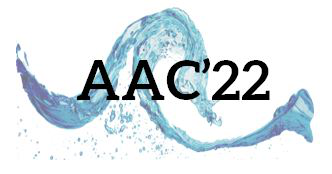Conveners
WG2: Computation for Accelerator Physics: Session 1
- David Bruhwiler (RadiaSoft LLC)
- Alexey Arefiev (UC San Diego)
WG2: Computation for Accelerator Physics: Session 8
- Alexey Arefiev (UC San Diego)
- David Bruhwiler (RadiaSoft LLC)
Traveling-wave electron acceleration (TWEAC) is an advanced laser-plasma accelerator scheme, which is neither limited by dephasing, nor by pump depletion or diffraction. Such accelerators are scalable to energies beyond 10 GeV without the need for staging and are candidates for future compact electron-positron colliders based on existing CPA lasers. TWEAC utilizes two pulse-front tilted laser...
PIConGPU, like many other codes, is ready for the next Exascale supercomputers. Heterogeneous programming as the main ingredient enables effective use of these machines. Important challenges still ahead are timely analysis of large scale simulation data and complex workflows for multi-physics simulations and machine learning.
As experimental capabilities progress and high-repetition rate...
An Eulerian finite-difference method solving the Vlasov equation is developed with a static, non-uniform momentum grid. The computational cost of this transformation differs negligibly from the uniform case with the same number of grid points. A general grid parametrization is tested against classic instabilities and driven cases and is found to provide significant efficiencies over the...
Numerical modeling of electromagnetic waves is a critical component of particle-in-cell simulation of laser–plasma interactions. Traditionally, laser pulses have been either launched from simulated antennas or initialized in their entirety in the computational domain. Relying on the electromagnetic field update to advance the laser pulse, however, imposes needless computational expense and...
By using the spinor representation of four-vectors, it is possible to write a simple expression for the momentum change of a charged particle in an arbitrary crossed field. It can be evaluated exactly if transcendental function evaluations are tolerable, or in an invariant-preserving expansion otherwise. We discuss progress in incorporating this approach into a particle-in-cell framework.
An efficient numerical algorithm for multi-level ionization of high-atomic-number gases has been developed. It is based on analytical solutions to the system of differential equations describing evolution of ionization states. The algorithm fully resolves multiple time scales associated with ionization processes coupled to electromagnetic processes of laser-plasma interaction. The effects of...
We present EZ, a novel Current Deposition algorithm for particle-in-cell simulations, which calculates the current density on the grid due to macro-particle motion within a time step by solving the electrodynamic continuity equation. Being a charge conserving hybridization of Esirkepov’s method and ZigZag, we refer to it as “EZ” as shorthand for “Esirkepov meets ZigZag”.
The talk will detail...

